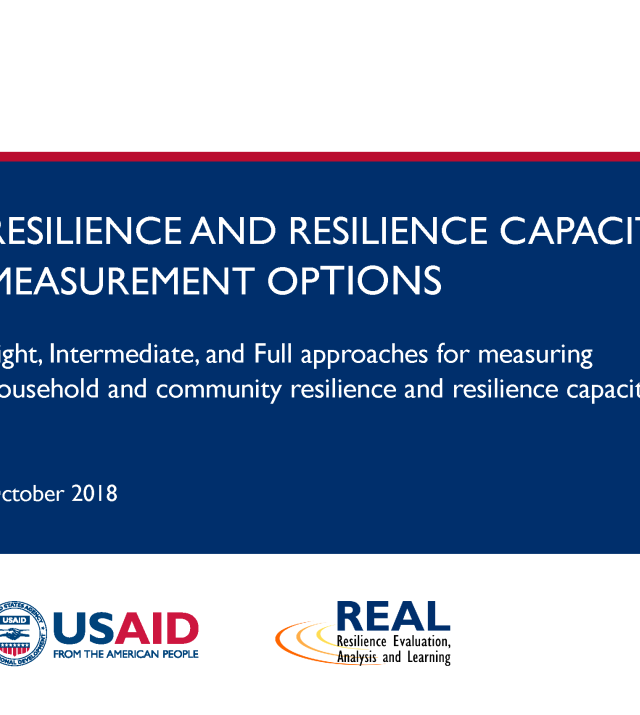
Resilience Measurement Practical Guidance Note Series: An Overview

Overview
The Resilience Measurement Practical Guidance Note Series synthesizes existing technical documents into pragmatic guidance to assist practitioners in integrating core aspects of resilience measurement into their program assessments, design, monitoring, evaluation, and learning. In seven parts, the series introduces key concepts and guides practitioners through the process of resilience measurement, from assessment to analysis.
In June 2018, the REAL Award organized a Short Course in Resilience Measurement consisting of three webinars that provided a deep-dive into the five guidance notes. You can read more about the course here. In October 2019 the REAL Award organized Session 4: Guidance Note 7 as a part of the REAL Short Course in Resilience Measurement. The recording of this session is available here.
Resilience Measurement Practical Guidance Series: Guidance Note 1 – Risk & Resilience Assessments
The purpose of this Guidance Note is to increase awareness and knowledge of the key elements and value of risk and resilience assessments and to provide resources for additional, deeper learning. It does not focus on best assessment practices which are already well covered elsewhere.
Resilience Measurement Practical Guidance Series: Guidance Note 2 – Measuring Shocks and Stresses
The first guidance note from USAID’s Resilience Measurement Practical Guidance series introduced resilience assessments and when, why, and how to conduct them. This Guidance Note in this series builds on the first by describing how to measure and analyze shocks and stresses.
Resilience Measurement Practical Guidance Series: Guidance Note 3 – Resilience Capacity Measurement
Resilience has emerged as a way to understand and address the increasing complexity and magnitude of risk in humanitarian and development contexts. Yet, the ability to develop strategies and programs that increase resilience requires robust measurement and analysis methods. This Guidance Note describes how to measure resilience capacities.
Resilience Measurement Practical Guidance Series: Guidance Note 4 – Resilience Analysis
Data analysis is a technical skill, and resilience analysis is no exception; it is anticipated that many readers will need additional technical assistance after reading this guidance note. This Guidance Note provides an overview of many of the quantitative and qualitative approaches used for resilience analysis, and identifies examples and resources for further exploration and capacity development.
Resilience Measurement Practical Guidance Series: Guidance Note 5 – Design and Planning for Resilience Monitoring and Evaluation at the Activity Level
This guidance note walks readers through the steps to be taken during the program cycle to plan for monitoring and evaluation - to better understand whether the resilience approach is contributing to households' and communities' ability to mitigate shocks and stresses.
Resilience Measurement Practical Guidance Note Series 6: Recurrent Monitoring Surveys
The Guidance Note draws on examples from multiple country and project contexts of what worked well, what challenges emerged and what solutions were developed while implementing an RMS. As such, this Guidance Note primarily focuses on measuring resilience at the individual, household and community level where much of this work has been done to date.
Resilience Measurement Practical Guidance Note Series 7: Cost-Benefit Analysis (CBA) in Resilience Programming
The purpose of Guidance Note 7, Cost-Benefit Analysis (CBA) in Resilience Programming, is to provide a resource for policymakers and implementing organizations looking to identify cost-effective resilience interventions and to prioritize development resources using an economic analysis tool called, Cost-Benefit Analysis (CBA).